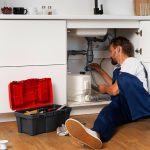Benjamin Franklin spoke of the value of an ounce of prevention all those centuries ago; it’s advice that still applies. Water heaters and furnaces may seem big, strong and indestructible, but they are fragile inside. With neglect, they can quickly go downhill. The high levels of heat and moisture that they are exposed to (yes, even blazing hot furnaces have moisture problems) means that they are prone to the effects of aging, rust and corrosion. Boilers are put through challenges such as sedimentation, clogging and leaks. Premature death in a large heating appliance can set you back thousands over a lifetime.
Take care of that sacrificial anode
Water boilers can easily stay rust-free for a quarter-century. To make this happen, electric boilers come with sacrificial anodes placed within the tank. When the tank of an electric water heater contains a sacrificial anode, it attracts the corrosive actions of water and the salts dissolved in it, sparing the main element and the tank. It’s an important step in boiler failure prevention to keep an eye on the anode and replace it when it corrodes.
Take a look at your water
If you have water that’s too soft or too hard, it can make life tougher on you heater. Your professional heater maintenance crew will advise you on it, recommending a water softener.
Excessive water pressure can hurt water heaters and other appliances. Anything greater than 80 psi can cause internal damage. If you don’t have a pressure reducing valve and an expansion tank, a professional water heater maintenance crew will recommend one.
Dust in your furnace can lead to corrosion
Neglected furnaces often have clogged filters. A clog can ruin efficiency, make for inconsistent heating and fill the house with soot. This isn’t the worst of what dust does, though. Dust attracts moisture, and moisture leads to rust. You want to be very regular with cleaning the dust filter on your furnace.
Cracks in the heat exchanger
The heat exchanger is one of the hardest working parts of a furnace. It experiences extremely high temperatures, and therefore needs proper inspection. It isn’t easy, though. It takes special tools and a close, painstaking inspection to find cracks. These are important to find, though. Cracks come with the possibility of carbon monoxide leaks and complete furnace failure.
There’s a long checklist to take care of
Unlubricated fan motors, belts and pulleys can lead to furnace failure. So can poorly maintained safety controls. It makes a lot of sense to call in an expert tech to have every point on the checklist touched upon.
Neglect simply isn’t smart, especially since heater maintenance, boiler maintenance and furnace maintenance don’t cost much. You will certainly need to set aside a couple of hundred dollars each year for a visit by a professional, and it’s worthwhile over the long run. It will add up to no more than $3,000 or $4,000 over a lifetime. It’s a pittance compared to the cost of repairs and expensive, premature heater replacements. Getting preventive maintenance is certainly a smart move.






Leave a Reply
You must be logged in to post a comment.